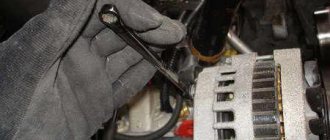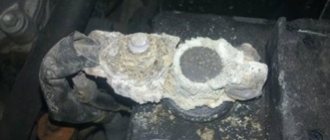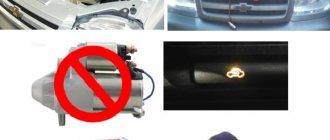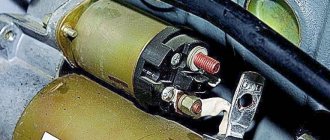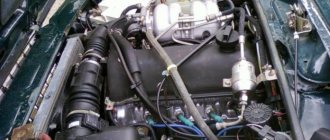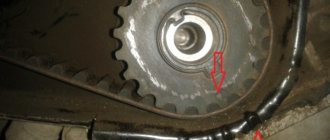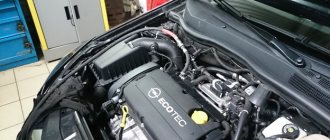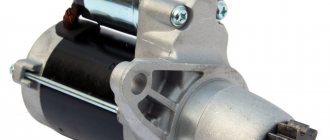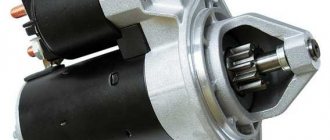According to reviews, the problem with floating engine speeds is familiar to many Lada Largus owners. This is especially true in winter, when the car has difficulty starting in cold weather (it is difficult to start the engine in the morning). In such situations, changing circles only make the situation worse. The tachometer needle may randomly jump from 1000 to 1500 rpm or not reach the "warm-up" level at all, remaining below the set minimum values. Experts do not recommend self-diagnosis of the car. If the cause of the problem is unknown, it is best to contact a service center.
Car engine modifications and their features
The reasons why the speed on Largus may fluctuate lie in differences in the technical characteristics of the engines. Depending on the configuration, an 8- or 16-valve engine is installed.
8-valve K7M 800
This engine model was borrowed from Renault Logan and Sandero. Such engines have been installed on Largus since 2010. The unit complies with the Euro-4 standard, its power is 83 hp. S. Of the minuses:
- floating minimum;
- high fuel consumption;
- lack of hydraulic lifters in the valve mechanism - it is necessary to adjust the gaps every 30,000 km;
- the need to replace the timing belt every 60,000 km: a broken belt will inevitably lead to bending of the valves;
- unreliability of crankshaft seals;
- vibrations and increased noise during operation of the power unit.
The 8-valve engine is too small for Largus. Among the advantages are the simplicity of the engine and inexpensive maintenance.
16-valve K4M
This engine is used only in the top modifications of Largus in the “Lux” configuration. Engine power is 106 hp, but still needs some work. It differs from the previous block:
- absence of vibrations and almost complete absence of noise;
- low fuel consumption.
The disadvantage of the 16-valve engine can be considered its complex design, which causes the high cost of the car. The engine life is approximately 450,000 km, but unit maintenance is more expensive. The main thing is not to use it often under increased loads and undergo maintenance on time.
Lada Granta does not start - spark plugs are in gasoline
If the unscrewed ones are wet, then it is logical to assume that gasoline is entering the cylinders. Accordingly, you need to dig towards the spark. Everything is definitely fine with the DPKV, because the ECU sees the scrolling and opens the injectors.
On a car with an 8-valve engine, where an ignition module is installed, this procedure is much simpler than on cars with a 16-valve engine. First, we need to make sure that voltage is supplied to the ignition module, namely, to the primary winding of the module. To do this, remove the chip from the module, and then turn on the ignition. There should be 12 volts between the center wire and ground. If they are not there, then check all the wiring to the control unit. If everything is fine with it, then with 90% confidence we can say that the problem is in the ECU. After we went to the cartoon, power is supplied, we check the module itself. To do this, use the same multimeter to check the resistance of the primary winding. It is measured between the second and third terminals of the coil.
The resistance should be about 1.2 kOhm. After this, we check the resistance of the secondary winding coils. To do this, it is measured between the terminals on high-voltage wires 1 and 4, as well as cylinders 2 and 3. This resistance may differ among different manufacturers, so here it is looked at relative to each other. On average, the indicator varies from 6.5 to 12. It is worth clarifying that this method of checking the module may not always be reliable, since the coil has different characteristics at different thermal conditions.
It remains to check the high-voltage wires; we measure their resistance with a multimeter; it should be no more than 5 kOhm on the shortest wire, and no more than 10 kOhm on the longest wire, respectively. Unfortunately, checking high-voltage wires for breakdown at home is quite problematic; this may require at least a megaohmmeter.
Many people, in the absence of a spark and wet spark plugs, immediately jump to check the crankshaft position sensor. Here it must be said that the fuel supply to the cylinder already indicates that this sensor is working. But how reliably it shows the position of the crankshaft is difficult to say. At home, it is easier to check the crankshaft position sensor by replacing it with a known good one.
Causes and methods of eliminating difficult engine starting
For a good engine start, a mixture of fuel and a spark from the spark plugs must simultaneously appear in its cylinders.
The engine cannot be started if one or more components have failed. This happens, for example, when the starter does not turn the crankshaft.
If floating idle speeds have become too annoying, and turning the engine by starting is no longer useful, it’s time to figure out the causes of the malfunctions that have arisen. The table shows the most common reasons why the Lada Largus engine speed fluctuates and may not start.
| It causes | Diagnosis and manifestations |
Means
Regular and timely maintenance of the car will minimize or completely eliminate possible problems with starting the Lada Largus engine.
You should not change all the parts randomly without first checking their functionality. Comprehensive diagnostics are required, since there may be several sources of malfunction at the same time. Engines of the same type are installed on modern cars of the VAZ family. For this reason, the solution to the problem will be almost the same for different cars.
Oxygen
As you know, anything needs oxygen to burn. Accordingly, a lack or absence of oxygen, as well as simulating a lack or absence of oxygen, can lead to the engine stalling immediately after you start it.
If the air filter is clogged, the engine may receive less air than needed. As a result, the mixture will be far from optimal and in extreme cases, the fuel-air mixture may become so lean that the car simply stalls. In such cases, you just need to replace the air filter.
As for the simulation, the mass air flow sensor may be responsible for this. Its incorrect readings can lead to the injector not injecting fuel at all, which means the car will stall. It is not always necessary to immediately change the mass air flow sensor; washing it with purified aviation kerosene often helps. Therefore, do not rush to run to the auto store if it turns out that the problem is in this sensor.
In older, carburetor cars, the throttle valve may cause the engine to stop a few seconds after it starts.
Air leaks as a cause of floating speed
Many owners note that in the morning, especially in winter, after starting the engine, the engine is unstable, the speed jumps and the car begins to twitch while driving. They look for a problem in the immobilizer or spark plugs, but if the diagnostics do not reveal problems, the problem is in the throttle body.
The malfunction is an air leak due to a loose connection between the throttle valve and the intake receiver. The problem is solved by replacing the o-ring with a similar new one or changing the design using adhesive tape. Procedure for replacing the ring:
- throttle cable disconnected;
- the rubber band securing the inlet pipe is removed;
- The plastic intake muffler has been removed;
- the power plug is disconnected from the IAC and throttle position sensor;
- the air filter mounting bolts are unscrewed;
- the throttle valve bolts are unscrewed;
- The old ring is removed and a new one is put on.
Then everything is put back together and tested for functionality.
The process of replacing the throttle valve O-ring takes a maximum of half an hour.
Although the engines were borrowed from well-known Renault models, they migrated under the hood of the VAZ Largus along with typical faults. However, you can fix the problem of mobile device inactivity yourself. If you lack confidence and experience, your best bet is to go to a gas station.
Tool:
- 10 mm spanner
- 13 mm spanner
- Multitester
- Final Attack Collar
- Key end extension
- 8 mm key attack
- Key connection 10 mm
- 13mm key attack
- Medium flathead screwdriver
- Fixed charger
- Pliers
Spare parts and consumables:
- Vaseline technical VTV-1 in aerosol packaging
- Sandpaper with a grain size of no more than P220 or felt with PMA-2 abrasive paste
- Starting system contact connections
- Egnition lock
- Starter traction relay
- They're flying
- Starter drive
Notes:
To confirm a malfunction of the engine starting system, the following deviations in the operation of other mechanisms are necessary, which can be seen by performing a series of actions described below.
1. When diagnosing the cause of abnormal engine starting, open the car door and watch how the brightness of the interior lighting lamps changes.
Note:
The brightness of the lighting lamp depends on its supply voltage. During normal starter operation, the interior lighting is slightly dimmed.
If the brightness of the lighting does not change, then the cause of the problem is usually an open circuit in the starting system control circuit.
If the lights go out almost or completely, the cause of the problem is most likely a short circuit or ground fault in the starter field windings or a faulty battery.
2. Do not knock on the starter as this may damage the starter parts.
Note:
In the past, it was not uncommon to see a technician pressing the starter while trying to figure out why it wasn't working. Often, shock loading would cause the commutator brushes, rotor, and bearing shells to align or move. In many cases, after using the starter, its performance was restored, although not for long.
But most modern starters use permanent magnets, which are fragile and can break if impacted. A broken magnet splits into several weak magnets. Some early permanent magnet starter designs had the magnets glued to the stator housing. With a strong blow to the starter, these magnets crumbled into pieces, which, hitting the rotor or bearing seats, led to complete destruction of the starter.
Causes and methods of troubleshooting the starting system.
The starter does not turn on
1. Defective battery - check the battery.
2. Oxidation of battery terminals and tips. Clean, secure, and lubricate the lugs and terminals with Vaseline as described in this article.
3. Broken contacts in the connections, broken wires in the starter power and control circuits: check, clean, tighten or replace the contact connections in the starter control and power circuits.
4. Malfunction of the ignition switch (lock) - replace the contact group of the ignition switch (lock).
5. The traction relay is faulty - replace the traction relay.
6. Faulty starter: Repair the starter by removing it as described here.
The traction relay is activated, but the starter armature does not rotate or rotates too slowly.
1. Battery is low: Charge or replace the battery.
2. Oxidation of battery terminals and cable ends. Strip, secure and lubricate the cable ends and terminals with Vaseline.
3. Loosely tighten the nuts securing the lugs to the traction relay terminals - tighten the nuts with wrenches.
4. Faulty starter: Repair the starter by removing it as described here.
The traction relay turns on and off immediately (frequent knocking)
1. Battery charge is very low: charge with a stationary charger or replace the battery.
2. Increased starter power circuit resistance - strip and secure cable lugs. Replace faulty cables.
3. The ignition switch (lock) is faulty - replace the ignition switch contact group (lock.
4. The traction relay is faulty - replace the traction relay.
The starter turns on, but the crankshaft does not rotate
Faulty Starter: Repair the starter by removing it as described here.
The starter turns on, but the gear does not engage
Nickel teeth on drive gear or flywheel rim - Remove teeth or replace flywheel or starter drive.
The starter does not turn off after starting the engine
1. The key is stuck in the ignition switch in position “D” - repair or replace the mechanical part of the ignition switch (lock.
2. Closing the contacts of the ignition switch (lock) - replace the ignition switch (lock.
3. Faulty starter: Repair the starter by removing it as described here.
Increased noise level when rotating the starter armature
1. Loose starter assembly: Tighten the starter mounting bolts.
2. The teeth of the starter drive gear or the flywheel ring gear are damaged - replace or repair the starter, replace the flywheel.
3. Faulty starter: Repair the starter by removing it as described here.
Article missing:
- Tool image
- Photos of parts and consumables
To properly start an internal combustion engine, it is necessary to have a prepared air-fuel mixture in the cylinders in the correct proportion, which is ignited by a spark from the spark plug at a strictly defined moment.
Additionally, all parts and components connected to the starter/ignition switch must be in good working order. The Lada Largus may have problems starting the internal combustion engine if some elements of the system are broken or do not work properly.
ATTENTION! I found a completely simple way to reduce fuel consumption! You do not believe me? Even a mechanic with 15 years of experience didn’t believe it until he tried it. Now save 35,000 rubles a year on gasoline! Know more"
Option one - battery
This is perhaps one of the most common types of malfunctions of this kind. Its essence lies simply in a discharged or inoperative battery. Determining discharged is simple:
If the cause is the battery, then it would seem that everything is simple - just charge it (or light it) and you can hit the road. But not everything is so simple, because the unclear reason that caused the consequence in the form of an unsuccessful launch will cause the same consequence again. Therefore, it is worth figuring out why the battery was discharged.
Everything is elementary if a light was simply left on somewhere, or another consumer was left on. But if everything was turned off, then it is necessary to check the quality of the generator, as well as the serviceability of the battery itself.
Starter not working
After turning the key to the “Engine Start” position, the starter begins to rotate the car’s flywheel and within 5 seconds under normal temperature conditions the Largus engine should start. If the starter does not work, it is possible that some elements have failed:
- Low voltage in the on-board network - the voltage at the battery terminals must be at least 12 V. When the voltage is lower, the car battery must be charged.
- The group of contacts of the ignition switch or starter relay is faulty - after turning the key, no power is supplied to the starter solenoid relay - you can measure the voltage at its contact using a voltmeter. A faulty ignition switch or relay must be replaced.
- The starter retractor relay is faulty: When 12V is applied to its contact, the relay does not operate (no characteristic click is heard) and the starter does not rotate. The retractor will need to be repaired or replaced.
- Incorrect starting: after applying voltage to its winding, the motor does not rotate. The first reason is wear of the brushes; replacing them is enough to eliminate the problem. The second reason is that the starting winding has burned out, in which case it is necessary to replace the entire part. The third reason is jamming of mechanical elements; To eliminate it, it is necessary to disassemble the electrical part of the starter and free wheel (bendex), wash all parts and lubricate with graphite lubricant.
There are several more reasons why the starter on the Lada Largus does not turn on, for example: Problems in the wiring or jamming of the internal combustion engine are much less common.
Worked intermittently, stalled and won't start
There are often situations when the car starts the first time, but constantly stalls. In such cases, there are four key reasons:
- The first reason may be problems with the ignition coils. It is necessary to inspect all electrical connections - damage is possible or they are simply loose. The malfunction is eliminated by replacing the failed part.
- Reason number two: low pressure in the engine fuel system. In this case, it needs to be diagnosed and repaired. The process, unfortunately, can be labor-intensive and only available at a car service center.
- In the third case, depressurization is observed in the connections of the vehicle’s intake tract components. The pipeline, receiver and catalytic manifold should be checked and the breakdown repaired.
- The fourth option is a malfunction of the engine control system as a whole or its individual units. Only diagnostics from specialists will help here.
The internal combustion engine does not start when the starter is working
If in the “Engine Start” ignition switch position the starter rotates, but the engine does not start, it is necessary to determine the serviceability of a number of elements.
| There is no gasoline in the tank. | On the instrument panel the fuel level arrow is at zero. | Fill with gasoline. |
| Low battery. | Typical crackling sound when trying to start. When checking, the voltage shows less than 12 V. | Charge the battery. |
| Poor contact of battery terminals or oxidation. | It crunches from under the hood. Low voltage on-board network. | Clean the terminals and fit them onto the battery terminals as tightly as possible. |
| There are no electrical connections for power and control systems | Checking the reliability of the connection of the wire blocks. | Connect the connectors securely. |
| Rotation of the crankshaft is prevented (seizing of the piston assembly, liner, shaft deformation, jamming of the water pump, generator). | Slow rotation of the crankshaft, extraneous noise when starting and running the engine. | Replacement of defective parts. |
| Ignition problems. | Pure sparks. | Check all elements and parts of the ignition system, replace if necessary. |
| High voltage cables are faulty or disconnected. | Inspection. | Install in the correct sequence, replace if necessary. |
| Broken or worn timing belt. | Visual inspection. | Replacing the timing belt. |
| The phase and gas distribution are disrupted. | Checking the position of the crankshaft and camshaft marks. | Set the steps according to the labels. |
| Malfunctions in the electronic engine control unit (ECU): crankshaft position sensors, coolant temperature sensors, phase sensors. | Find out if power is supplied to the ECU; if there is an open circuit, check the condition of the sensors. | If necessary, change the ECU software or replace the ECU in addition to the sensors. |
| IAC (idle air control) has failed. | Check the IAC (if the engine starts only when the accelerator pedal is pressed and goes out when released). | Replace the regulator. |
| The fuse or control relay has blown. | Check relays and fuses. | Once you have eliminated the cause of the blown fuses, replace them. |
| Fuel pump faulty, fuel pump relay fuse blown. | After turning the ignition key, there is no characteristic sound of a pump in the gas tank when fuel begins to flow into the rail. Check the fuse, apply voltage directly from the battery. | Replace faulty parts. |
| The fuel filter is clogged, water in the fuel line is freezing. | Measure the pressure in the fuel system. | Replace the fuel filter and fuel line parts. |
| Low pressure in the fuel rail. | Check the pressure, fuel pump filter and fuel line for damage. | Replace the fuel filter or pump, fuel pressure regulator. |
| Faulty injectors. | Check the functionality of the injectors. | Replace faulty parts. |
| Air in the intake system. | Inspect the air intakes for air leaks, check the vacuum brake booster. | Eliminate air leaks, replace the faulty brake booster. |
| Diagnostics | Malfunction | Liquidation procedure |
| The internal combustion engine runs slower than usual, and extraneous sounds are heard in the engine compartment. | Motor oil can harden at low temperatures. Jamming of engine attachments: water pump, generator. Destruction of the connecting rod and piston group elements - scuffs on the liners or cylinders. | Park your car in a warm parking lot to warm up the oil. Poor quality oil - replace. |
| Replace generator/water pump or repair wedge. | ||
| Repair the internal combustion engine. | ||
| Fuel tank arrow in empty position | Without gasoline | Fuel your car |
| When the key is turned to the “on” position, the fuel pump is not heard. | The pump is not powered. | Remove the fuel pump, apply voltage to the terminals, if the pump works, check the power circuit (fuse, relay, wiring), as well as the alarm. |
| The pump has failed. | Replace the faulty pump with a new one. | |
| The engine can be started with the accelerator pedal depressed; After release the engine is switched off. | The idle speed control sensor is faulty. | Install a new sensor |
| The engine tries to start jerkily, you can hear crackling sounds from the exhaust, strong vibration | There is no spark, the spark occurs at the wrong time. | Check spark. Check that the high-voltage cables or ignition coils are connected correctly in accordance with the connection diagram. |
| Check the crankshaft position sensor and replace if necessary. | ||
| Insufficient pressure in the fuel rail. | Fuel pump wear. | Replace the pump. |
| The fuel filter is clogged. | Replace the filter. | |
| The fuel line is damaged. | Inspect the fuel line for kinks or other damage. | |
| In cold weather, the water in the fuel system may freeze. | Preheat the frozen line to positive temperature. | |
| Fuel injectors that do not deliver gasoline | Faulty injector, electrical problems. | Measure the injector resistance, it should be 12 ohms. Replace the faulty injector. |
| Check wiring. | ||
| Engine control unit does not work | There is no 12V power supply on the engine control unit. | Check the power supply to the control panel. |
| ECU failure | Replace block. | |
| Air leak in the intake manifold. | Damage to the intake manifold. | Replace or repair the collector. |
| Damage to vacuum tubes. | Replace hoses or tighten clamps. | |
| Violation of the tightness of the intake tract | Change the intake manifold gaskets. |
If the Lada Largus does not start and the starter spins, and a superficial inspection does not produce results, it is advisable to check the integrity of the timing belt and the correct valve timing. To do this, it is necessary to remove the protective cover, inspect the timing belt for integrity, tension and damage (lack of teeth, tears).
Then check the alignment of all marks on the belt, rollers and pulleys. A broken timing belt can be checked more easily and quickly. Unscrew the oil filler cap on the engine, make sure that when you try to start the internal combustion engine, the camshaft rotates, part of it is visible under the cap.
Why the Lada Granta does not start, causes of malfunctions
A car's ignition system is a set of instruments and devices that provide an electric spark that ignites the air-fuel mixture in the engine cylinders at the right moment. Problems with starting the engine occur if one or more elements of the system fail. Do you know how to determine why a Lada Granta car won’t start?
In the Lada Granta repair book, part of the chapter is devoted to this problem, which is called “Diagnostics of vehicle malfunctions and methods for eliminating them”:
The Grant won't start, the starter won't turn:
- The car battery is low. Charge it or replace it with a new one.
- Battery terminals are oxidized or not tight enough. Strip and tighten.
- Malfunction in the starter electrical circuit. Check the chain.
- Starter drive parts are faulty. Check the starter and repair if necessary.
- The starter traction relay is faulty. Check the starter and repair if necessary.
- The starter motor (armature, windings, brush assembly) is faulty. Check the starter and repair if necessary.
- The ignition switch is faulty. Check and repair if necessary.
- The flywheel ring gear is damaged or worn. Replace flywheel.
Grant won't start, the starter turns:
- There is no gasoline in the fuel tank. Fill with gasoline.
- The battery is discharged and the crankshaft is not rotating fast enough. Charge or replace the battery.
- Battery terminals are oxidized or not tight enough. Strip and tighten.
- There is no tightness in the engine power supply system, or the fuel pump or fuel pressure regulator is faulty. Check the system and replace parts.
- The timing belt (gas distribution mechanism) is broken. Replace the belt.
- The Lada Granta engine management system is faulty. Run diagnostics.
- The electrical circuit of the ignition coils is faulty. Check and replace.
- The crankshaft position sensor (CPS) or its circuit is faulty. Check and replace.
Granta will not start when the engine is cold:
- The battery is discharged and the crankshaft is not rotating fast enough. Charge or replace the battery.
- The vehicle's power supply (fuel) system is faulty.
- The coolant temperature sensor (DTOZH) of the engine management system is faulty.
- Fuel injectors are leaking. Check and replace if necessary.
- Low compression in cylinders.
- The engine control system is faulty. Run diagnostics.
Lada Granta does not start when hot:
- The air filter is clogged. Replace with new one.
- The vehicle's power supply (fuel) system is faulty.
- Battery terminals are oxidized or not tight enough. Strip and tighten.
- The engine management system coolant temperature sensor is faulty.
Lada Granta starts and immediately stalls:
- Ignition coil electrical connections are loose or damaged.
- Insufficient pressure in the vehicle's fuel system.
- The connections of the intake tract parts are leaking (catalytic manifold or intake manifold receiver).
- The engine control system is faulty. Run diagnostics.
Let us remind you that regular vehicle maintenance will help eliminate engine starting problems.
Tips to make diagnosis and repair easier
To diagnose a malfunction in a Lada Largus car, special tools and devices may be required. If there are problems with the fuel supply, you need to measure the pressure in the fuel rail; for this you will need a special pressure gauge with an adapter. If it is missing, you can unscrew the gas supply pipe from the rack, lower it into an empty container, turn on the ignition and measure how many liters of fuel the pump pumps in one minute. A working Lada Largus pump pumps about one and a half liters of fuel in one minute.
The performance of the crankshaft position sensor can be checked using an ohmmeter, a device that shows electrical resistance. The working sensor has a resistance of about 250 Ohms and as a metal object approaches it, this value should change.
The presence of a spark can be easily checked by disconnecting the high-voltage cable or ignition coil from the spark plug and moving the contact 2-3 mm from the metal element of the engine. When starting an internal combustion engine, an electrical charge - a spark - will jump between the wire/coil and the engine element. During the procedure, you need to use special insulating gloves or tools.
Granta won't start - spark plugs are dry
After the spark plugs have been removed, we inspect them. Dry spark plugs indicate that gasoline is simply not supplied to the cylinders. There are many reasons for this, but the main ones are quite typical. First of all, turn on the ignition, and then listen to see if the fuel pump is working. If it doesn’t work, then we listen to see if the fuel pump relay clicks after turning on the ignition. If it does not click, it means there is no voltage supplied to it, and this in turn means that either the fuse has blown or the problem is in the ignition switch. We almost completely exclude the second option, because this is a special case that requires separate consideration.
After we have made sure that voltage is supplied from the ignition switch to the fuse, and then from the fuse to the fuel pump relay, we lift the back seat, and then remove the chip from the fuel pump. Here we need either a multimeter or a test lamp. Turn on the ignition, the lamp should light up, or the multimeter should show a voltage of 12 volts at the terminals of the block. If there is none, then we look for a break along the path from the fuel pump turn-on relay to the fuel pump itself. It is worth clarifying that this is a very rare case, which in practice is almost impossible; you should start the search from the chip itself; most likely, the wire broke at its base.
After we are convinced that the fuel pump is pumping fuel, we go into the engine compartment, find the fuel rail, unscrew the cap from it, and then press the spool. Naturally, this must be done with the ignition on. What is all this for? This is necessary in order to clarify whether the fuel rail is pressurized. The pressure in the fuel rail may not build up at all; the reason for this is most likely either the fuel filter, which is clogged, or the fuel pressure regulator in the fuel rail.
Checking the filter is quite simple. To do this, you need to disconnect the fuel supply from the fuel rail and then turn on the ignition. You need to put some old one under the hose; a working fuel system will fill a liter bottle pretty quickly. In order to check the fuel pressure regulator, you need to pinch the hose that goes from the ramp to the fuel tank. This is the so-called return. We pinch it, and then press the spool. With a clean fuel system and a working pressure regulator, fuel will definitely flow from the spool.
All injectors cannot fail at once, so it is logical to assume that for some reason the control unit does not send impulses to them. One of the reasons for this behavior may be the operation of the immobilizer, which blocks the operation of the injectors because it does not recognize the key. In this case, the buzzer will notify the driver with a double signal.
If this does not happen, then take a multimeter in your hands, turn on the ignition, and then measure the voltage between the red-pink wire that goes to the injectors, as well as the ground of the car. The fact is that the injectors in this case are controlled by minus, that is, plus is constantly supplied to them. The minus is supplied in pulses under the control unit. If positive comes to the injectors, then it is logical to assume that the control unit does not understand the position of the crankshaft. Naturally, we look at the crankshaft sensor chip.
Alternative ways to start the engine
You can start a car with a malfunction in the starting / ignition switch system by towing or “push-pull”. To do this, you need to turn on the ignition, tighten the clutch when engaging second gear at the gearbox, accelerate the car to a speed of 10-15 km/h and release the clutch. If the engine starts, disengage and come to a smooth stop.
There are situations when it is impossible to accelerate the car to the required speed. In this situation, if the problem is not in the starting winding or jamming of its elements, you can start the car by simply short-circuiting the contacts with a screwdriver or a large wrench. To do this, you need to turn on the ignition and turn off the transmission gearbox. Next, find the starter under the hood, remove the protective rubber film from the wires and close the two large opposite contacts. After starting the engine, open the indicated contacts.
These actions must be performed while ensuring your own safety and the safety of others.
Lada 4×4
Remove the rear support bracket for the intake pipe by unscrewing the two bolts with a 13mm wrench.
We remove the starter protective shield by unscrewing its fastening nuts with a “13” wrench.
From the bottom of the car, unscrew the two bolts securing the starter. From the engine compartment side, move the starter forward and disconnect the block with wires.
We unscrew the nut and disconnect the wire tip from the contact bolt of the traction relay. Remove the starter from the engine compartment.
By the way, do you know that the ignition system of LADA cars can be improved, for example, by abandoning the ignition key in favor of a start/stop button.
Do-it-yourself spare wheel for the Lada Largus car door
The Largus spare wheel is installed on the door using a special basket called a bracket. Fixation is carried out in the luggage area. Installing the rim causes problems for many car enthusiasts, so they prefer to carry a spare tire in the trunk.
Bracket for spare wheel
Lada Largus is a small car, and the spare wheel at the rear makes it look massive. Factories began to produce special baskets that allow the wheel element to be fixed outside rather than inside the car. Mass production appeared due to the high demand for products. The bracket allows you to hold not only the wheel, but even the tire. Bracket specifications:
- length, width – 55 cm each;
- height – 30 cm;
- weight – 5 kg.
The basket will allow you to fix the spare wheel on the surface of the stern door without damaging the body. The bracket does not need to be registered like a trailer. Its cost starts from 4,000 rubles. The price will be higher if the product is equipped with fasteners. It is better to purchase the Lada Largus spare wheel mount for the rear doors separately, since the factory element has a lot of shortcomings: short pins, lack of nuts, weak steel.
If previously the wheel was moved due to the desire to install a gas cylinder in the luggage compartment, now it is the final touch of the upgrade. For this purpose, several options for car brackets are used:
- Rotary type. It is installed on the right door.
- Product screwed to the bottom.
Fastenings are made to standard points on the body; technologists have provided special holes for fixing.
Advantages and disadvantages
Not all Largus are equipped with baskets, since additional fastening has advantages and disadvantages:
| pros | Minuses |
|
|
Some manufacturers provide fasteners, a cover for the spare tire, or a hard plastic cap with a company logo along with the product, but drivers assure that it is more profitable to buy each element separately.
Bracket selection and installation
It is better to purchase the original, but if the driver wants to save money, then you can buy an analogue. The basket is made of metal and has a chrome-plated or painted surface. Chrome is preferable as the paint will peel off over time.
When installing a spare wheel on the Largus rear door, you should take care of reliable fastenings, since they will hold the part and the spare wheel. It is better to purchase bolts with massive nuts and a cross-shaped tip. Such hardware can be found in any automotive store.
Along with the hardware, you should prepare a screwdriver, a ratchet wrench, and take care of an assistant who will support the device while another screws the structure. Algorithm of actions:
A special sealing gasket is provided with the basket, so the protective part is installed first using bolts. The bracket is attached to the top with three screws
It is important to ensure that the gasket is securely clamped between the body and the basket. The hook is fixed in the central hole and handle. The levers that will hold the spare tire are being installed. The wheel is installed.. The hardware should be tightened using a wrench with a special pad that allows you to firmly fix the fasteners
The hardware should be tightened using a wrench with a special pad that allows the fasteners to be firmly fixed.
Removing and installing the spare tire on the Largus door
On the Lada Largus, the spare wheel bracket on the trunk door looks organic, which cannot be said about the bottom. The central hook is the main element that takes the weight of the spare tire. For dismantling you will need screwdrivers, a wrench and an assistant. The wheel is fixed according to the instructions:
Fastenings become loose. The handle, which is located next to the hook, is removed
The handle is the main protection for the wheelbase from falling out of the basket. The wheel tilts a little, it is important to hold it with your hands while the lower bolts are unscrewed. After this, the spare tire is easily removed.
To return the spare tire to its place, you need to reattach the handle and tighten the hook screws well.
Problems with the starter, ways to solve them on Lada Largus
It is customary to divide breakdowns into electrical and mechanical based on the nature of their origin.
Electrical
The most common type of failure. The section of electrical wiring from the steering column to the starter must be inspected.
Signs:
- Slow rotation of the rotor,
- The control unit does not respond when current is applied,
- The starter clicks but does not turn. Most likely there is an interturn short circuit, a broken wiring, a faulty solenoid relay,
- Wear of armature, brushes.
To make diagnostics as productive as possible, rule out the following breakdowns. To do this you need to check:
- presence of charge in the battery,
- tightness of battery terminals,
- wiring integrity. First of all, we inspect the area from the steering column to the control panel, and then the remaining ones,
- serviceability of the ignition switch. Backlash, poor contact, and delays in turning are unacceptable.
Mechanical
A stationary crankshaft with a working starter is a sign of a malfunction of the overrunning clutch, pressure spring, wear of the retaining ring, or flywheel. A metallic grinding noise during rotation indicates wear on the flywheel teeth and possible breaks. If the starter does not start, then the reason is a faulty electrical part.
After starting the motor, the launcher continues to rotate:
- jamming of the spring, drive shaft,
- contact board sticking,
- wear of the solenoid relay,
- The bearing race is damaged.
